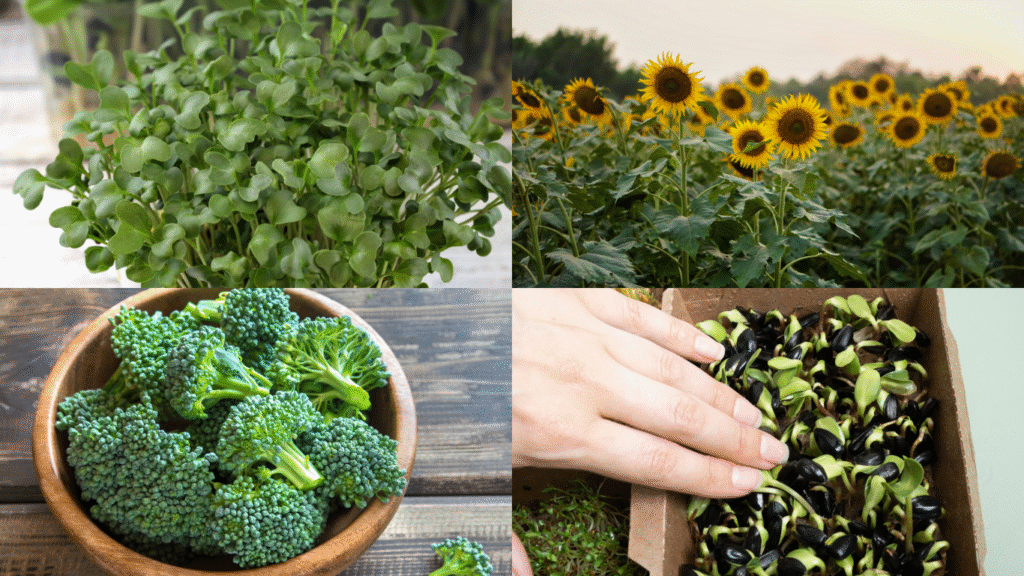Microgreens vs. mature versions: are they really more nutritious?

We have often mentioned that many studies claim microgreens contain more nutrients than their mature counterparts. However, we have usually made this comment only superficially, without properly verifying it. In today’s article, we will explore this topic in depth, based on scientific evidence.
What do we know? exploring the scientific studies…
The recent study “Microgreens. A Comprehensive Review of Bioactive Molecules and Functional Foods” indicates that microgreens have elevated levels of minerals such as potassium (K), phosphorus (P), calcium (Ca), zinc (Zn), iron (Fe), magnesium (Mg), and sodium (Na).
Another study, “Nutrient Content of Micro Baby Green and Field Grown Vegetables”, compared microgreens with fully grown field vegetables and found that microgreens showed higher concentrations of certain nutrients (though this varied by species and growing method).
In addition, according to a press release from the United States Department of Agriculture (USDA) and the American Chemical Society (ACS), cruciferous microgreens can contain up to five times more glucosinolates than their mature counterparts.
In what aspects do they seem to outperform mature vegetables?
Minerals and microminerals
Microgreens generally show higher concentrations of several essential minerals per gram of weight. For example, broccoli and mustard microgreens can contain up to twice as much iron (Fe) and calcium (Ca) as their mature versions, while amaranth and sunflower microgreens stand out for their high magnesium (Mg) and zinc (Zn) content, key minerals for energy and immune function.
To illustrate this simply: a small serving of broccoli microgreens (about 25 g) can provide as much iron as a whole cup of cooked spinach.
Bioactive compounds
Microgreens are especially rich in natural antioxidants such as polyphenols, flavonoids, carotenoids, and glucosinolates. These compounds help protect cells from oxidative stress and contribute to the color, flavor, and aroma of the sprouts.
For example, red cabbage microgreens can contain up to 40 times more vitamin E and almost 30 times more lutein zeaxanthin than mature cabbage, while radish or mustard microgreens show higher concentrations of glucosinolates, responsible for their spicy flavor and potential anticancer properties.
Nutrient density
Since they are harvested early and have little mature foliage, their “nutrition per gram” tends to be more concentrated, making them valuable when consumption volume is low.
A small handful (about 20 – 25 g) of red cabbage microgreens can contain levels of vitamin C and carotenoids similar to, or even higher tan, those in a full cup of the same mature cabbage.
Therefore, even though they are consumed in smaller amounts, their nutritional density tends to be higher.
What we should not forget
Variability among species and growing conditions
Not all microgreens outperform their mature versions in the same way. Species, substrate, light, harvest timing, and other factors play a major role.
Study limitations
Many studies are based on small samples or controlled conditions, which limits how well their results apply to real world scenarios.
Actual health effects
A higher nutrient content does not automatically mean better absorption or the same biological effect. Research on human health effects remains limited.
Costs
Although microgreens offer advantages, their production can involve higher costs, which affects accessibility.
It’s also important to keep in mind that…
• If microgreens are grown with the goal of maximizing nutritional value, it’s best to choose species known for their comparative advantage (for example, certain cruciferous plants) and optimize growing conditions to reflect these results.
• Chefs, restaurateurs, and other food businesses can take advantage of this nutritional edge as part of their value proposition, emphasizing that microgreens are not just decorative, they also provide nutrient density.
• For people following specialized diets, microgreens can be a strategic option, though always as a complement, not a full replacement for mature vegetables or complete meals.
• In marketing and communication, accuracy matters: it is better to say that microgreens “may contain more nutrients” rather than claim they are “completely superior,” given the available evidence and ongoing research.
In conclusion…
Current studies support the claim that microgreens, in many species and under good growing conditions, can offer higher concentrations of certain nutrients or bioactive compounds than their mature versions.
However, the advantage depends on the species, cultivation method, harvest timing, and quality of the final product.
Ultimately, within a healthy diet, microgreens should be viewed as a complement, not a full replacement, for mature vegetables.
As always, we hope this has been helpful.
See you next time!
Carlota
Sources
American Chemical Society. (2023, August 15). Microgreens and mature veggies differ in nutrients, but both might limit weight gain. ACS Newsroom. https://www.acs.org/pressroom/newsreleases/2023/august/microgreens-and-mature-veggies-differ-in-nutrients-but-both-might-limit-weight-gain.html
Ayeni, A. (2021). Nutrient content of micro/baby-green and field-grown mature foliage of tropical spinach (Amaranthus sp.) and roselle (Hibiscus sabdariffa L.). Foods, 10 (11), 2546. https://pmc.ncbi.nlm.nih.gov/articles/PMC8619766/
Bhaswant, M., Shanmugam, D. K., Miyazawa, T., Abe, C., & Miyazawa, T. (2023). Microgreens—A comprehensive review of bioactive molecules and health benefits. Molecules, 28(2), 867. https://pmc.ncbi.nlm.nih.gov/articles/PMC9864543/
Samuolienė, G., Brazaitytė, A., Viršilė, A., Miliauskienė, J., Vaštakaitė-Kairienė, V., & Duchovskis, P. (2019). Nutrient levels in Brassicaceae microgreens increase under tailored light-emitting diode spectra. Frontiers in Plant Science, 10, 1475. https://europepmc.org/article/med/31798616
Ware, M., RDN, L.D. (2023, July 28). Health benefits of microgreens. Medical News Today. https://www.medicalnewstoday.com/articles/316075







